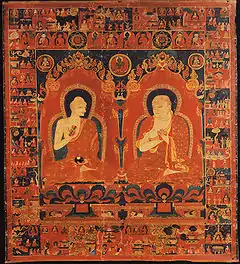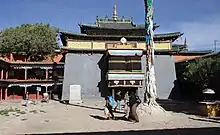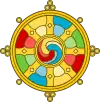Shalu Monastery
Shalu Monastery (Tibetan: ཞྭ་ལུ།, Wylie: zhwa lu ) is small monastery 22 kilometres (14 mi) south of Shigatse in Tibet. Founded in 1040 by Chetsun Sherab Jungnay, for centuries it was renowned as a centre of scholarly learning and psychic training and its mural paintings were considered to be the most ancient and beautiful in Tibet. Shalu was the first of the major monasteries to be built by noble families of the Tsangpa during Tibet's great revival of Buddhism, and was an important center of the Sakya tradition.


| Shalu Monastery | |
|---|---|
Tibetan transcription(s) Tibetan: ཞྭ་ལུ། Wylie transliteration: Zhwa-lu Official transcription (China): Xalu THL: Zhalu Other transcriptions: Shalu Chinese transcription(s) Traditional: 夏魯寺 Simplified: 夏鲁寺 Pinyin: Xiàlǔ Sì | |
 | |
| Religion | |
| Affiliation | Tibetan Buddhism |
| Sect | Shalu Sakya |
| Location | |
| Location | Shigatse Prefecture, Tibet, China |
| Architecture | |
| Founder | Chetsun Sherab Jungnay |
| Part of a series on |
| Tibetan Buddhism |
|---|
 |
Repair and reconstruction
Repair and reconstruction of Shalu Monastery began on May 13, 2009, according to the Chinese government Xinhua online news. "The project, one of Tibet's biggest heritage renovation projects under the 11th Five Year Plan (2006–2010), involves reinforcement of its buildings, maintenance of sewage treatment facilities and improvement of fire and flood control systems", a prefectural government official said. It is planned to spend more than 16 million RMB yuan on the project.[1]
Notes
- "Archived copy". Archived from the original on 2009-05-17. Retrieved 2010-08-01.CS1 maint: archived copy as title (link)
External links
- Shalu Monastery - The Shalu Association
- Exhibition
Further reading
- Vitali, Roberto. 1990. Early Temples of Central Tibet. Serindia Publications. London. ISBN 0-906026-25-3. Chapter Four: "Shalu Serkhang and the Newar Style of the Yüan Court." Pages 89–122.
- von Schroeder, Ulrich. 2001. Buddhist Sculptures in Tibet. Vol. One: India & Nepal; Vol. Two: Tibet & China. (Volume One: 655 pages with 766 illustrations; Volume Two: 675 pages with 987 illustrations). Hong Kong: Visual Dharma Publications, Ltd. ISBN 962-7049-07-7. Zhwa lu («shalu») monastery, pp. 554, 922, 925, 1085, 1088, 1129: Zhwa lu gSer khang («shalu serkhang»), 554, 842, 922, 925; Figs. XIV–14–16, XV–8. Jo khang («jokhang»), p. 922; Pls. 47C, 229A, 230C, 231B, 231D, 314A, 329E. gNyer khang byang («nyerkhang chang»); Pls. 268C–D, 301A, 313A, 324E. gTsug la g khang («tsuglakhang»); Pl. 292A. Yum chen mo lha khang («yum chenmo lhakhang»), pp. 842–843; Figs. XIII–14–16. gZhal yas lha khang byang («shalye lhakhang chang»), pp. 439, 441, 913, 922; Figs. VII–3–4, XV–2; Pls. 169A, 169B, 229B, 229C, 230A, 230B, 231A, 231E, 322B. gZhal yas lha khang lho («shalye lhakhang lho»), pp. 922, 1129; Pls. 232B–C, 233B–C, 234B, 252D–F, 315A, 315B, 315C, 315D, 315E, 318D, 318E.
External link
 Media related to Shalu Monastery at Wikimedia Commons
Media related to Shalu Monastery at Wikimedia Commons